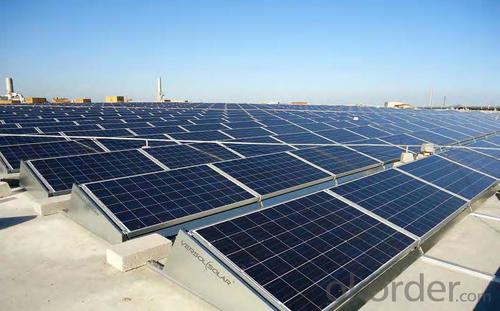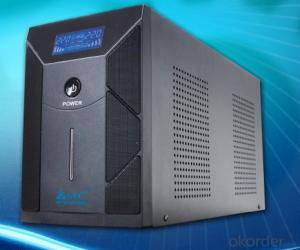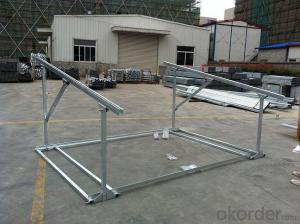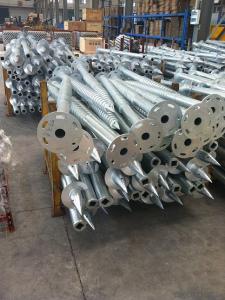Wind Water Solar Energy Systems Windstream System Solar Mounting System
- Loading Port:
- China Main Port
- Payment Terms:
- TT OR LC
- Min Order Qty:
- -
- Supply Capability:
- -
OKorder Service Pledge
Quality Product, Order Online Tracking, Timely Delivery
OKorder Financial Service
Credit Rating, Credit Services, Credit Purchasing
You Might Also Like
Project site Flat roof
Module specification All modules with frame
Installation inclination 10° -15°
Module arrangement Portrait
Module area square Client arrangement
Module area position Client arrangement
Bottom frame AL 6063T5
Supporting leg Stainless steel
Deflector Zinc plated Al-Ma board or stainless steel
Small piece Stainless steel, Al 6063T5
Bottom pieces No mechanical connection, system fixation depend on self-
weight and air flow pressure.
- Q: Can solar energy systems be used in conjunction with other energy sources?
- Yes, solar energy systems can be used in conjunction with other energy sources. This is known as a hybrid energy system, where solar power can be combined with other sources such as wind, hydro, or conventional energy grids. By integrating multiple energy sources, it can enhance the reliability and efficiency of the overall energy system, ensuring a consistent power supply even in varying weather conditions or high energy demand.
- Q: Can solar energy systems be combined with other renewable energy sources?
- Yes, solar energy systems can be combined with other renewable energy sources. This combination is known as hybrid renewable energy systems. By integrating solar with other sources such as wind, hydro, or geothermal energy, we can maximize the generation of clean and sustainable power while ensuring a more stable and reliable energy supply. This approach allows for better utilization of resources and enhances the overall efficiency of the renewable energy system.
- Q: Can solar energy systems be used in powering beauty salons or spas?
- Certainly, beauty salons and spas can utilize solar energy systems to effectively power their establishments. Solar energy is a source of power that is both renewable and sustainable, enabling these establishments to decrease their reliance on traditional electricity and minimize their carbon footprint. Installation of solar panels on the rooftop or other suitable areas allows beauty salons and spas to generate their own electricity, resulting in long-term cost savings. Beauty salons and spas typically have high electricity requirements for operating various equipment such as hair dryers, hair straighteners, curling irons, lighting, and air conditioning. Solar energy systems are capable of meeting these power demands, particularly during daylight hours when the sun is shining. Any excess electricity generated during the day can be stored in batteries or directed back into the grid, ensuring a continuous and reliable power supply. Furthermore, by adopting solar power, beauty salons and spas can enhance their sustainability and environmental performance. This transition to solar energy enables these establishments to significantly reduce their carbon emissions and actively contribute to the global fight against climate change. Additionally, the use of solar energy can attract environmentally conscious customers who value businesses that prioritize sustainability. To summarize, solar energy systems present a viable solution for powering beauty salons and spas. They provide a dependable and sustainable source of electricity, while also offering cost savings and supporting greener and more environmentally friendly business practices.
- Q: Can solar energy systems be used for powering electric bike charging stations?
- Yes, solar energy systems can be used to power electric bike charging stations. Solar panels can be installed on the roofs or in the vicinity of the charging stations to capture sunlight and convert it into electricity. This renewable energy can then be used to charge the electric bike batteries. By utilizing solar power, electric bike charging stations can operate independently from the electric grid, reducing reliance on fossil fuels and lowering carbon emissions. Additionally, solar energy systems can provide a cost-effective and sustainable solution for powering electric bike charging infrastructure.
- Q: Can solar energy systems be used in cold storage facilities?
- Yes, solar energy systems can be used in cold storage facilities. Solar panels can generate electricity to power refrigeration systems and other equipment in cold storage facilities. Additionally, solar thermal systems can provide heat for defrosting purposes or to maintain optimal temperatures inside the facility. Implementing solar energy systems in cold storage facilities can help reduce operating costs and carbon emissions.
- Q: Can a solar energy system be installed on a building with a flat roof?
- Yes, a solar energy system can be installed on a building with a flat roof. In fact, flat roofs are often preferred for solar panel installations due to their ease of access and optimal sunlight exposure. Solar panels can be mounted directly on the flat surface of the roof using ballast, which is a weight-based system that does not require any roof penetrations. Additionally, flat roofs provide ample space for arranging the solar panels in an optimal manner, maximizing the energy production. Therefore, flat roofs are an excellent option for installing solar energy systems and can contribute significantly to generating clean and sustainable electricity.
- Q: Can a solar energy system be installed on a ground mount?
- Indeed, it is possible to install a solar energy system on a ground mount. In reality, ground-mounted solar systems are highly popular and offer numerous advantages compared to roof-mounted systems. Ground-mounted systems typically have a larger size and can accommodate a greater number of solar panels, resulting in increased energy production. They can also be positioned at the ideal angle and orientation to maximize sunlight exposure, which may not always be achievable on a roof. Furthermore, ground-mounted systems are more easily accessible for maintenance and cleaning since they are not situated on the roof. Therefore, if there is ample space available on your property, opting for a ground-mounted solar energy system can be an exceptional choice for generating clean and renewable energy.
- Q: How do solar energy systems impact the electric grid?
- Solar energy systems positively impact the electric grid by generating clean and renewable electricity. They help reduce the demand on the grid during peak hours and contribute to a more balanced and reliable power supply. Additionally, excess energy generated by solar systems can be fed back into the grid, reducing the need for traditional power plants and promoting energy independence.
- Q: Can solar energy systems be used in powering government buildings or offices?
- Government buildings or offices can definitely utilize solar energy systems as a means of power. In fact, numerous governments across the globe have already embraced solar energy as a sustainable and cost-effective solution to fulfill their electricity needs. There are multiple reasons why solar energy systems are highly suitable for government buildings or offices. Firstly, these buildings often possess spacious rooftops or open areas that are well-suited for the installation of solar panels. These panels have the ability to convert sunlight into electricity, which can then be utilized to power the buildings' lighting, HVAC systems, and other electrical appliances. Secondly, solar energy systems offer substantial cost savings in the long run. Although the initial investment may be higher in comparison to traditional energy sources, solar panels have a long lifespan and require minimal maintenance. This makes them a financially appealing option for government agencies, as they can reduce their dependence on costly grid electricity and save taxpayer money over time. Moreover, by utilizing solar energy, government buildings can significantly diminish their carbon footprint and contribute to environmental sustainability. Solar power is a clean and renewable energy source that generates no greenhouse gas emissions during operation. This aligns with the global efforts to combat climate change and achieve sustainability goals. Furthermore, solar energy systems can also serve as a reliable source of electricity, especially when combined with energy storage technologies like batteries. This ensures that government buildings or offices have a continuous power supply, even during grid outages or emergencies. In conclusion, solar energy systems are a practical and advantageous choice for powering government buildings or offices. They offer a multitude of benefits, including cost savings, environmental sustainability, and reliable electricity supply. As governments worldwide strive to transition to clean energy sources, solar power is increasingly gaining popularity as an ideal option for powering government infrastructure.
- Q: How much space is required for a solar energy system?
- The amount of space required for a solar energy system varies depending on several factors such as the size and type of the system, the location, and energy needs. Generally, rooftop solar panels require an area of about 100-400 square feet per kilowatt of installed capacity. Ground-mounted systems may require more space, typically ranging from a few hundred to several thousand square feet. It is recommended to consult with a solar installer to determine the specific space requirements for a particular solar energy system.
Send your message to us
Wind Water Solar Energy Systems Windstream System Solar Mounting System
- Loading Port:
- China Main Port
- Payment Terms:
- TT OR LC
- Min Order Qty:
- -
- Supply Capability:
- -
OKorder Service Pledge
Quality Product, Order Online Tracking, Timely Delivery
OKorder Financial Service
Credit Rating, Credit Services, Credit Purchasing
Similar products
Hot products
Hot Searches
Related keywords























